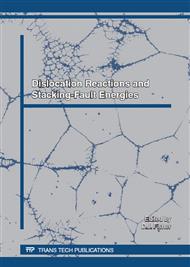[1]
The AZo Journal of Materials Online,. AZoM™. com Pty. Ltd Copyright © 2000-2012, Aluminium Alloys - Aluminium 5754 Properties, Fabrication and Applications, Supplier Data by Aalco.
Google Scholar
[2]
Positron Annihilation Spectroscopy, I. Procházka, Materials Structure, 8(2) (2001).
Google Scholar
[3]
Positron-Electron Annihilation, Carl Akerlof, 2008, University of Michigan.
Google Scholar
[4]
Modeling Momentum Distribution of Positron Annihilation Radiation in Solids, Ilja Makkonen, Laboratory of Physics, Helsinki University of Technology, Espoo, Finland, September, (2007).
Google Scholar
[5]
Computerized Data Reduction and Analysis in Positron Annihilation Coincidence Doppler Broadening Spectroscopy, A. Harrich, S. Jagsch, S. Riedler and W. Rosinger , American Journal of Undergraduate Research, 2(3) (2003).
DOI: 10.33697/ajur.2003.024
Google Scholar
[6]
http: /msg. igcar. gov. in/mpd/mps/index. php/positron-lifetime-spectroscopy.
Google Scholar
[7]
http: /palsfit. dk.
Google Scholar
[8]
http: /www. gordonengland. co. uk/hardness/vickers. htm.
Google Scholar
[9]
ASM Handbook online, volume 8, mechanical testing and evaluating, hardness testing.
Google Scholar
[10]
Dieter, G.E., Mechanical Metallurgy, 1988, SI metric edition, McGraw-Hill, ISBN 0-07-100406-8.
Google Scholar
[11]
Walker, P.M.B., Materials Science and Technology Dictionary, 1999, Chambers Harrap Publisher, ISBN 0 550 13249 x.
Google Scholar
[12]
N.A. Kamel and S.A. Aly, Investigation of Defects in Al-Si10 Alloy Using Electrical Measurements, Australian Journal of Basic and Applied Sciences, 5(7): 27-31, 2011, ISSN 1991-8178.
Google Scholar
[13]
Quenching Fundamentals; Quenching of Aluminum Alloys: Cooling Rate, Strength, and Intergranular Corrosion, Patricia Mariane Kavalco, Lauralice C. F and George E. Totten, Heat Treating Progress, 9(7) (2009).
DOI: 10.1201/9781351045636-140000221
Google Scholar
[14]
Ralph R. Sawtell and Craig L. Jensen, Mechanical Properties and Microstructures of Al-Mg-Sc Alloys, 21A (1990).
Google Scholar
[15]
I.K. Mackenzie, P.C. Lichtenberger, Applied Physics, 9 (1979) 331.
Google Scholar
[16]
Emad A. Badawi, M. A. Abdel-Rahman, and M. S. Abdallah, Thermal Vacancies and Self-Diffusion Energy in 2024 Al-Alloy by Positron Annihilation Lifetime Technique, Physica Status Solidi C, 6(11) (2009) 2349.
DOI: 10.1002/pssc.200982139
Google Scholar
[17]
Formation Energy in Al-Mg Alloy by Positron Annihilation Lifetime Technique (PALT), Mamduh Abedl-Rahman, Emad Badawi, Essmat Mahmoud Hassan, Gamal Yahya, Turkish Journal of Physics, 26 (2002).
Google Scholar
[18]
C.W. Schulte and J.L. Campbell: Applied Physics, 19 (1979) 269.
Google Scholar


